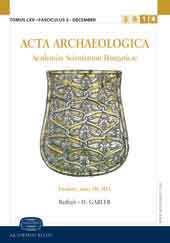Komposition und Stil der Jagddarstellungen der Budakalászer Messingkanne
Composition and style of the hunting depictions of the Budakalászer brass jug
Author(s): Tivadar VidaSubject(s): Archaeology, Customs / Folklore, Ethnohistory, Ancient World
Published by: Akadémiai Kiadó
Keywords: Late antique and early Byzantine art and toreutics; relief works; hunting scenes;
Summary/Abstract: As bas-reliefs of a similar standard are not known in the early Bizantine world, the styles of the figures and the ornamental elements of the jug are compared to the relief works of other fields of art (silver toreutics, ebony carvings, plastic relief, mosaics), since they met the same ideological and aesthetic demands, which necessarily led to the same stylistic solutions (figure-carpets-style). The scenes are characteristically divided into isolated zones without the existence of a narrative contact. The isolated scenes represent combats between people and animals (venation) in their pure dramatic appearances. This suspense is eased by the agility that can be read from the posture of the hunters. Yet they are hunting scenes and as antithetic combats they bear isolated effects on the spectators. The representation of the people and the animal is true to nature, they do not cover each other and thus they have strong contours and a more emphatic plasticity. Contrary to the individual scenes, the composition of the friezes on the Budakalász jug does not give a dynamic impression since the scale relations are diverse in the individual scenes. A definite aspiration to a formal abstraction can be felt in the composition of the friezes and the order of the scenes. The message is cyclically repeated in the cyclical iteration of the endless series of pictures. The hunter is not an everyday person: he is a hero (heros) who triumphs (virtus) over the difficulties of life.
Journal: Acta Archaeologica Academiae Scientiarum Hungaricae
- Issue Year: 60/2009
- Issue No: 1
- Page Range: 97-114
- Page Count: 18
- Language: German
- Content File-PDF

